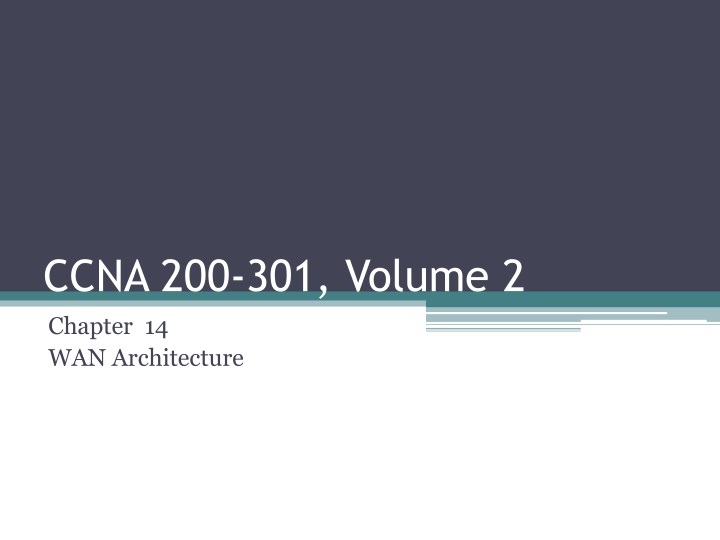
WAN Architecture and Metro Ethernet Concepts
Explore WAN architecture characteristics, VPNs, and Metro Ethernet concepts including IEEE Ethernet standards, MEF service types, topologies, and protocols for effective networking solutions.
Uploaded on | 3 Views
Download Presentation

Please find below an Image/Link to download the presentation.
The content on the website is provided AS IS for your information and personal use only. It may not be sold, licensed, or shared on other websites without obtaining consent from the author. If you encounter any issues during the download, it is possible that the publisher has removed the file from their server.
You are allowed to download the files provided on this website for personal or commercial use, subject to the condition that they are used lawfully. All files are the property of their respective owners.
The content on the website is provided AS IS for your information and personal use only. It may not be sold, licensed, or shared on other websites without obtaining consent from the author.
E N D
Presentation Transcript
CCNA 200-301, Volume 2 Chapter 14 WAN Architecture
Objectives Describe characteristics of network topology architectures WAN Describe remote access and site-to-site VPNs
Metro Ethernet Concept as a Large Ethernet Network
Ethernet Access Links into a Metro Ethernet Service
IEEE Ethernet Standards Useful for Metro Ethernet Access Name Speed Distance 100Base-LX10 100 Mbps 10 Km 1000Base-LX 1 Gbps 5 Km 1000Base-LX10 1 Gbps 10 Km 1000Base-ZX 1 Gbps 100 Km 10GBase-LR 10 Gbps 10 Km 10GBase-ER 10 Gbps 40 Km
Three MEF Service Types and Their Topologies MEF Service Name MEF Short Name Topology Terms Description Ethernet Line Service E-Line point-to- point Two customer premise equipment (CPE) devices can exchange Ethernet frames, similar to concept of leased line. Ethernet LAN Service E-LAN Full Mesh Acts like a LAN, in that all devices can send frames to all other devices. Ethernet Tree Service E-Tree Hub-and- spoke; partial mesh; point- to-multipoint A central site can communicate to a defined set of remote sites, but the remote sites cannot communicate directly.
Point-to-Point Topology in Metro Ethernet E-Line Service Between Routers
Using Multiple E-Lines, One for Each Remote Site
MetroE Ethernet LAN ServiceAny-to- Any Forwarding over the Service
E-Tree Service Creates a Hub-and- Spoke Topology
Routing Protocol Neighbor Relationships over Metro Ethernet E-Line
Layer 3 Forwarding Between Remote Sites Through Central Site
Layer 3 Forwarding Between Sites with E-LAN Service
MPLS VPN QoS Marking and Reaction in the MPLS WAN
Routing Protocol Neighbor Relationships with MPLS Customer Edge
MPLS VPN Using Redistribution with MPBGP at PE Router
Three Examples of Internet Access Links for Companies
Wiring and Devices for a Home Cable Internet Link
Wireless Internet Access Using 3G/4G/5G Technology
VPN Tunnel Concepts for a Site-to-Site Intranet VPN
Comparisons of Site-to-Site and Remote Access VPNs Remote Access TLS One On-demand Site-to-Site Typical security protocol Devices supported by one VPN (one or many) Typical use: on-demand or permanent IPsec Many Permanent













